TINKERING with the EDGES
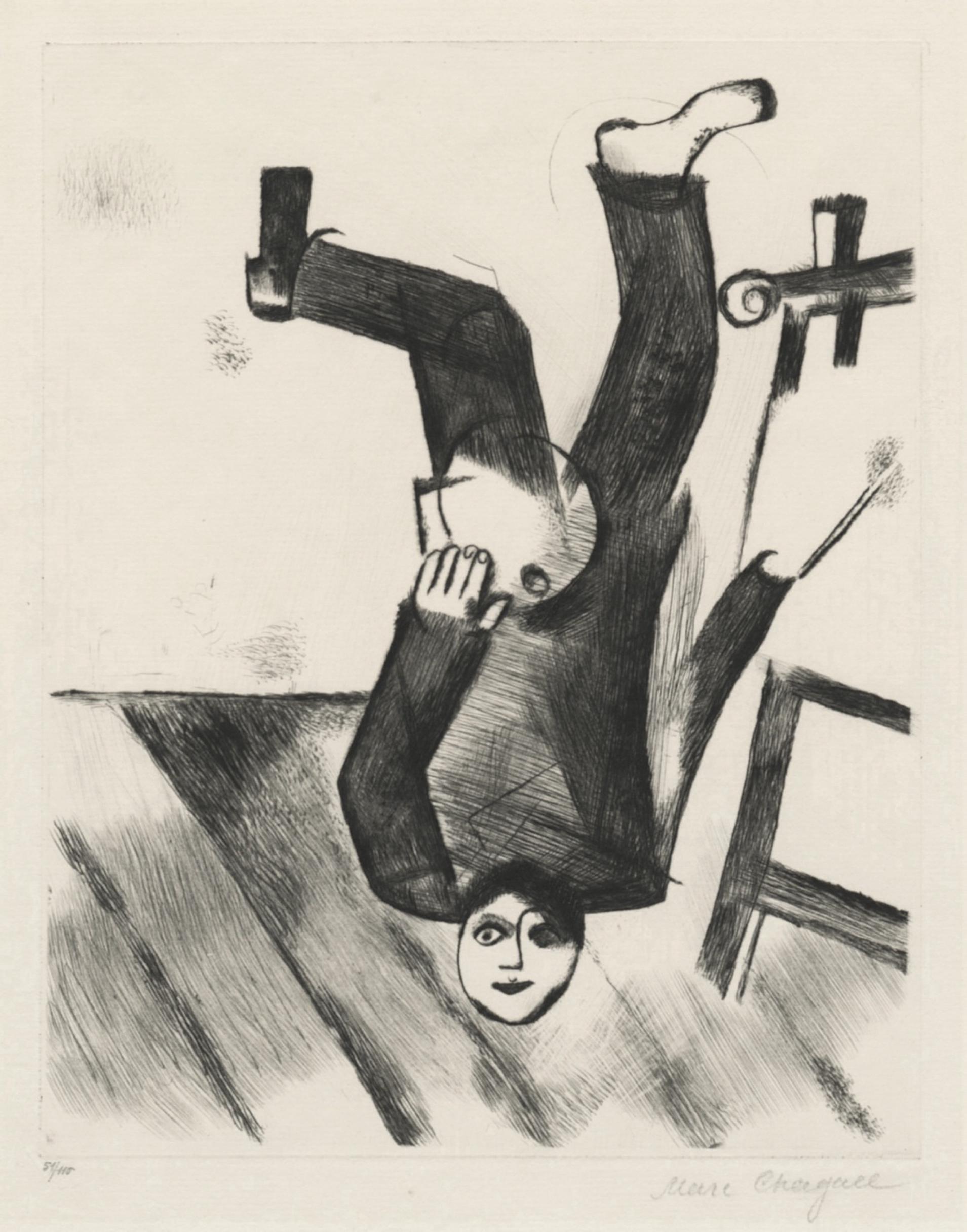
Surrealism from the 1920s to the 1940s
Cover image: Marc Chagall, “An der Staffelei,” or, “At the Easel,” from Mein Leben, drypoint, 1922.
The ancestry of Surrealism can in part be traced to art in France at the end of the 19th century. Redon’s hallucinatory visions are among its forerunners, as well as the mystical and theosophical philosophies of Kafka’s mature writings and Kupka’s abstract painting. Surrealism was led by the French poet and critic André Breton, and grew out of the anti-art “Dada” movement that flourished from 1918 into the early 1920s.
Initially literary in character, Dada sprung from a desire to move the world in a new direction, away from the nationalistic, materialistic and industrial ideals that had spawned World War I. Its explicit nihilism attracted many visual artists, such as Ernst, Masson, Dali and Tanguy, but it was soon caught in its own limitations, particularly in the concepts of free association and automatism.
In 1924, André Breton formalized Surrealism when he published his first Surrealist Manifesto. The movement was quickly embraced by artists throughout Europe and the U.S., and Paris became the hub of its activities with Breton recognizing, and then dismissing, “official” members as he saw fit. The membership list was remarkable: Arp, Dali, de Chirico, Ernst, Giacometti, Hayter, Klee, Magritte, Masson, Matta, Miró, Paalan and Tanguy to name just a few. (Picasso never became a formal Surrealist though his work was admired by the group).
In the early 1930s there were two print studios in Paris that were actively working with Surrealist printmakers. One was Roger Lacourière’s studio and the other, founded by Englishman Stanley William Hayter, came to be known as Atelier 17. Ernst, Miró and Tanguy worked at both but it was Atelier 17 that brought together a broad, international gathering of artists, both noted and unknown, working as equals with this new “language” they were all learning.
This new, surreal language required what was sometimes referred to as “relevant investigations” into both real and imagined phenomena. It examined the unexplained worlds of the psyche: dreams, the unconscious and the subconscious, violence, dark emotions such as fear, horror, and anger, and of course, death and birth. It questioned history and formal ideas, traditions and culture. It examined the unknown depths of the universe and the sea, and studied mythology and the so-called “primitive” cultures of Africa, Pre-Columbian America, and Polynesia. Surrealism would become basically two branches: the Freudian, concentrating on dreams and the subconscious; and the Jungian, emphasizing non-thinking, stream-of-consciousness, and “automatism,” which evolved into Abstract Expressionism in the 1940s and 50s.
Here, we have curated twenty-five Surrealist works on paper from the 1920s to the 1940s which examine these aspects of Surrealism. The collection includes original fine prints, drawings, and watercolors, and has been organized chronologically to see the evolution of techniques and styles. Descriptions include the title, medium, date, editioning and publisher where applicable, and references when available.
For more information, please contact the Annex Galleries: artannex@aol.com / (707) 546-7352 / www.annexgalleries.com
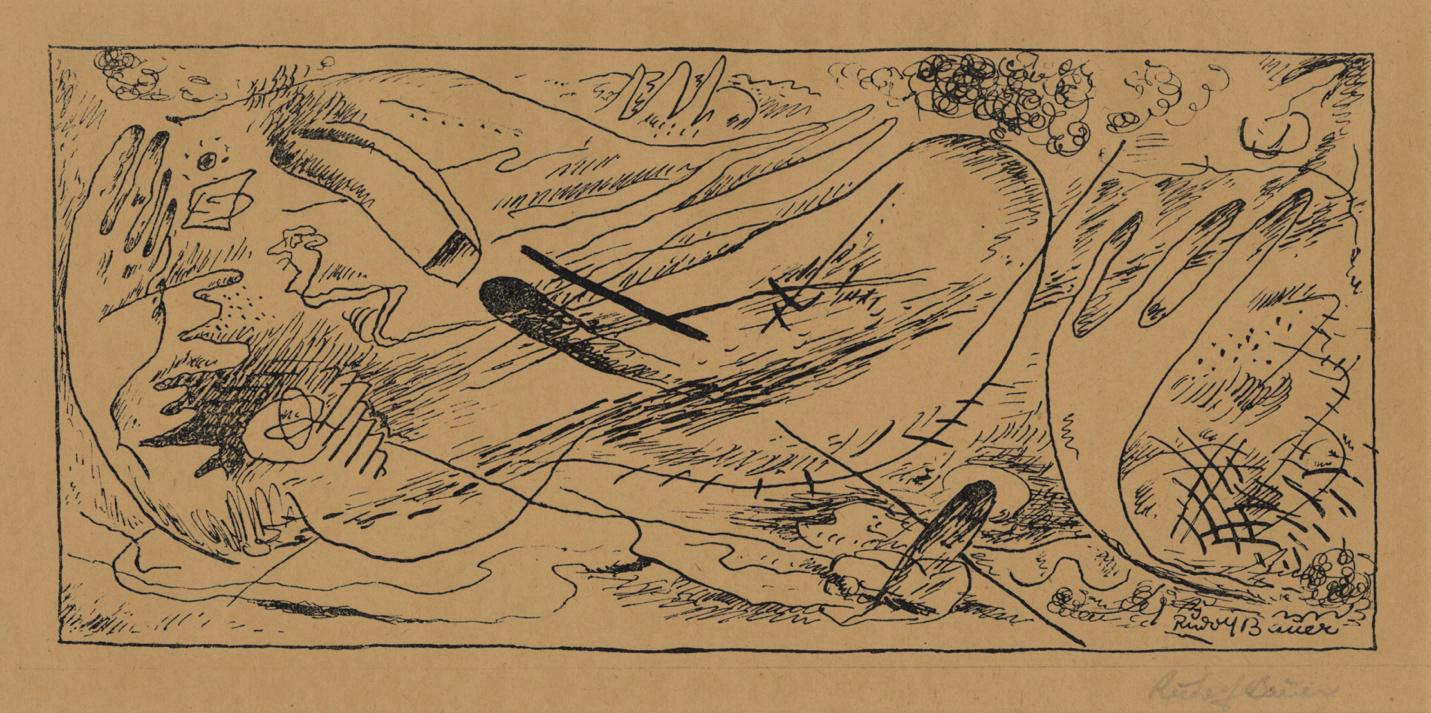
Untitled (surreal composition)
Lithograph, ca. 1915-‘20; pencil signed; edition not stated; 5-1/4 x 11-7/16” image size; printed by the artist on dark buff wove paper. Inventory number 15552. $600.
An early Surrealist lithograph created during the epoch of modernism and the avant-garde in Germany prior to the Second World War. Rudolf Bauer was an early contributor to Der Sturm, the art and literary magazine that focused on the rising, edgier movements of the early 20th century: Expressionism, Cubism, Dada, and Surrealism. Bauer worked in both non-objective and figurative subjects throughout his career, though in the United States he became especially known for the paintings commissioned by Solomon Guggenheim.
Less than a decade after Bauer created this piece - appearing at once entirely non-objective but with hints at his penchant for the erotic - he would be among those whose works were branded "degenerate" by Hitler's government. However, Bauer defied this branding and in an effort to fight against it he continued to exhibit throughout Europe and in the United States.
After one particularly successful debut at the Louvre's Jeu de Paume museum, he returned to Berlin, whereupon he was immediately arrested (despite not being Jewish, Roma, or otherwise persecuted for a religion or ethnicity) and sent to a concentration camp. Fortunately his situation was discovered by friend and admirer Filippo Marinetti, an Italian Futurist, who was able to have him freed and given a visa allowing him to immigrate to New York. He remained there until his death in 1953.
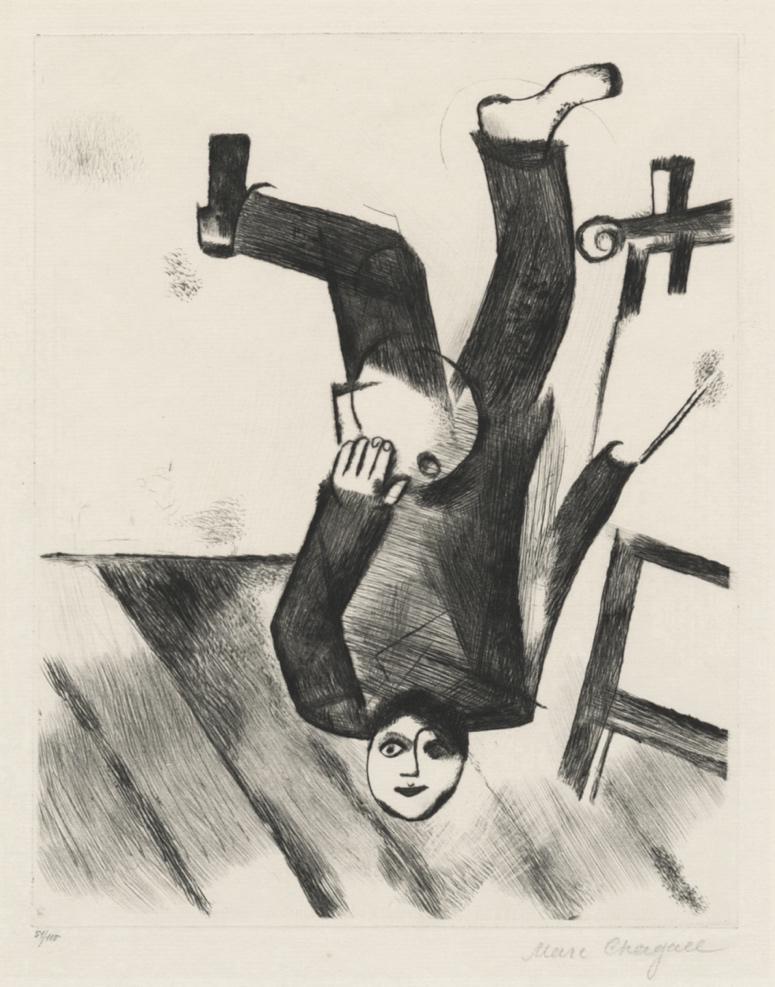
Marc Chagall ( Russian/French: 1887 - 1985 )
An der Staffelei; or, At the Easel – from ‘Mein Leben’
Drypoint, 1922; editioned 51/100; pencil signed; 9-3/4 x 7-7/16 platemark; printed and published by Paul Cassirer on ivory laid paper. Reference: Kornfeld 18; plate 18 of Mein Leben portfolio of 20 drypoints/etchings. Inv. no. TOPE105. $18,000.
Plate 18 from the seminal portfolio Mein Leben, which marked the beginning of Marc Chagall's love affair with printmaking.
"At the Easel" is one of the most recognized works of Chagall's early printmaking career, and is exemplary of his navigation through the ever-evolving Modernist sensibilities of the time. By the 1920s he was emerging from his beginnings in Cubism and Fauvism and was absorbing the theory of Surrealism, surrounded as he was by the pioneers of the genre. However, he refrained from applying any label to his own work, and remained anchored to his own fantastic universe with a symbology developed in his own visual language. Here, he "stands" at an easel with his feet in the air, his chin on the floor, his palette and brush in his hands and an inscrutable expression on his face.
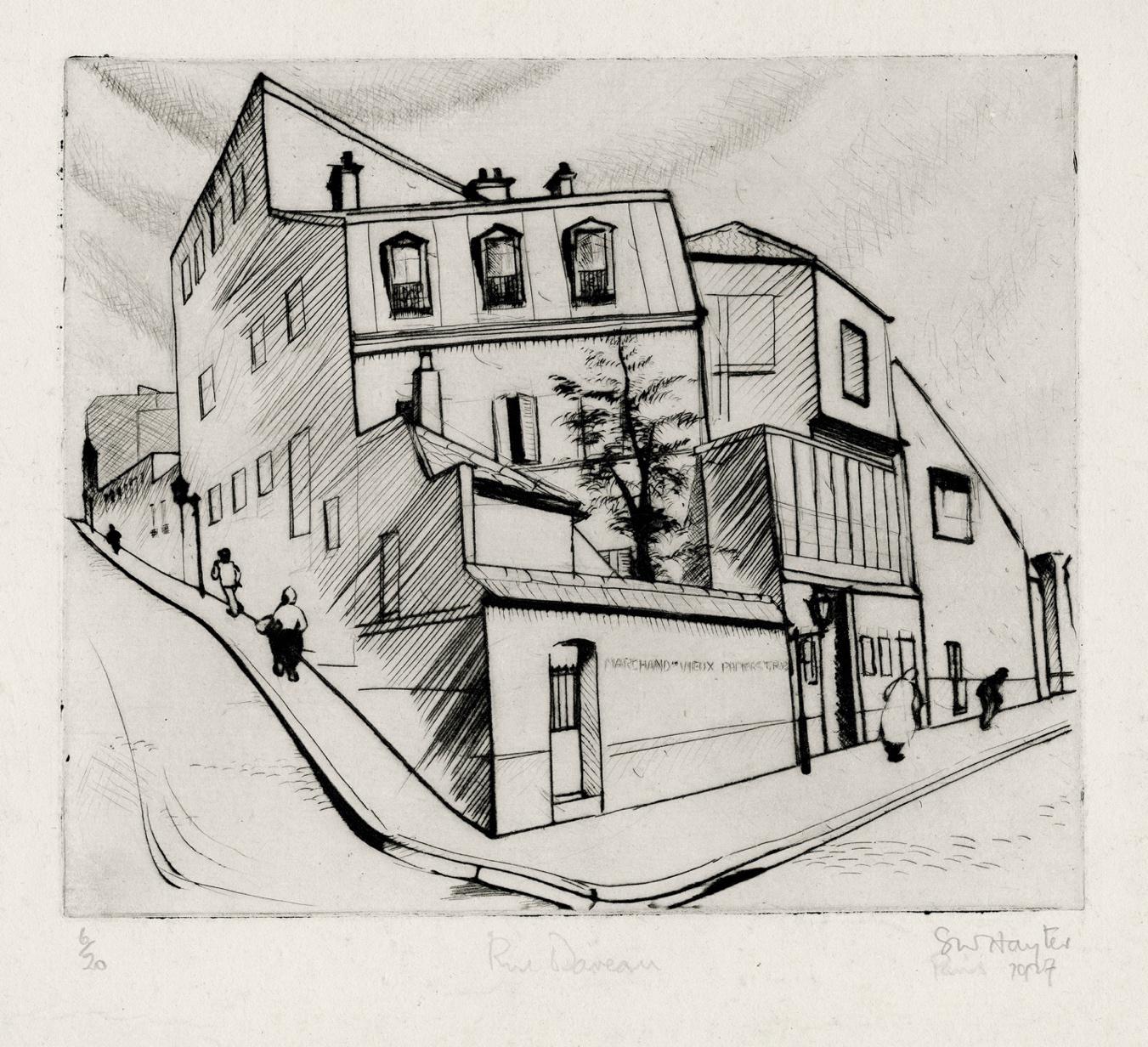
Stanley William Hayter ( British : 1901 - 1988 )
Rue Dareau
Drypoint, 1927; editioned 6/20; pencil signed; 7-3/4 x 9-1/4” platemark; printed by the artist at Atelier 17 on ivory Montval laid paper. Ref: Black & Moorhead 24. Inv. no. GMC141. $6,500.
Rue Dareau was completed in 1927, Hayter’s twenty-fourth print in what was to become an oeuvre of over 450. This print anticipates the Paysages Urbains portfolio of 1930, containing six Parisian architectural prints which began his movement toward the psychic automatism of the new Surrealist movement.
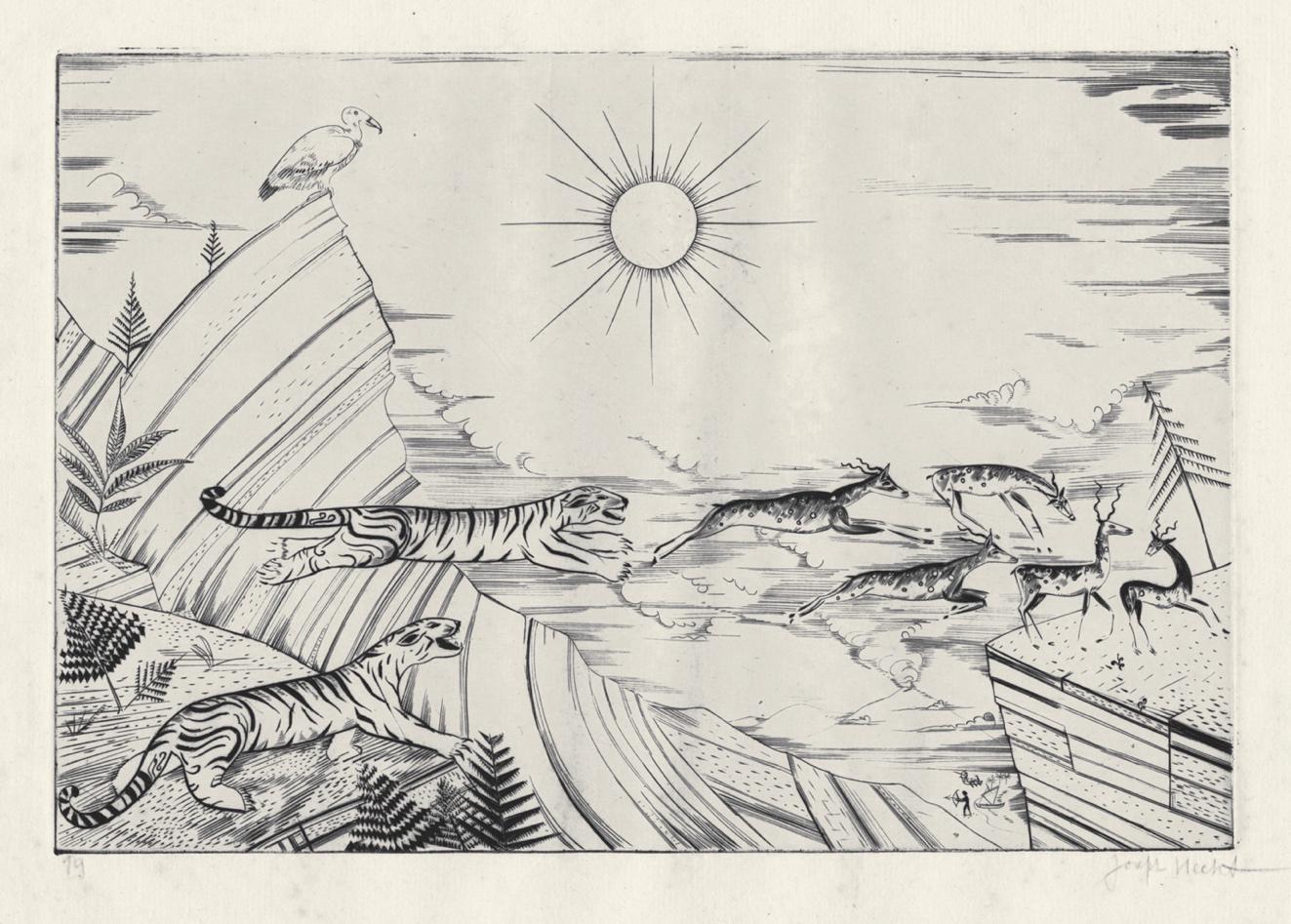
Joseph Hecht ( Polish : 18 91 - 195 1 )
Asie – from ‘Atlas,’a portfolio of seven images illustrating the poem by André Suarès
Engraving, 1928; pencil numbered 19, from the published edition of 150; 7-13/16 x 11-9/16” platemark; signed; on ivory Montval laid paper made for the artist with his coat-of-arms watermark, by Raphael, son of Gaspard Maillol at the Vidalon-le-Bas workshop. Ref: Tonneau-Ryckelnyck & Plumart 157-164, p. 73, fig. 161. Inv. no. 23585. $1,200.
Joseph Hecht collaborated with poet Andre Suares (1868-1948) to illustrate his poem “Atlas” of 1928, for which Hecht created seven engravings. "Asie" is the fourth image in the series of Surreal landscapes and depicts two tigers chasing antelopes which are jumping a deep chasm. In the valley far below are human hunters, and perched above the action is a single buzzard.
Hecht met Stanley William Hayter in 1926, when he instructed him in the art of engraving and the technicalities of printmaking. He would become pivotal to Hayter’s career and the Surrealism movement when he encouraged Hayter to open a cooperative printmaking studio, which became Atelier 17.
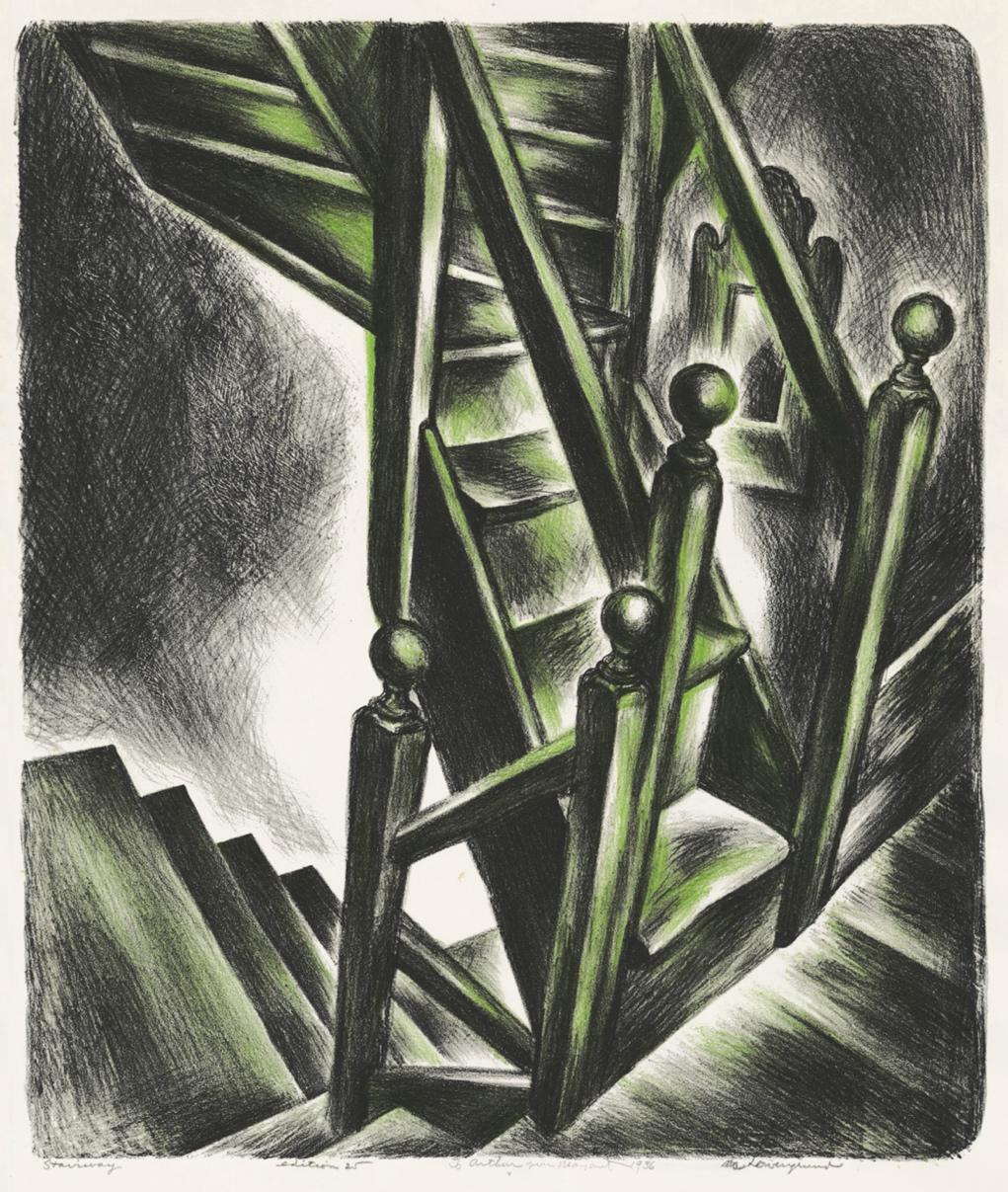
Margaret Lowengrund ( American: 1905 - 1957 )
Stairway
Color lithograph, 1933; edition of 25; pencil signed; 13-3/4 x 11-1/2” image size; printed by the artist on thick ivory wove paper. Ref.: Weyhe Gallery cat. No. 30 from the 1933 exhibition, “50 Modern Prints.” Inv. no. 24981. $1,000.
This strange, Modernist stairway is almost like an M.C. Escher view, with steep stairs twisting around and upward, seeming to be splitting into two parts at the top. A mirror hangs on the wall in the background, and the scene is eerily tinged in acid green. A tenement torture chamber. This image precedes the W.P.A. of the mid 1930s, but like the project only had an edition of 25.
Lowengrund would go on to found The Contemporaries Gallery in New York in 1951 and make printmaking history, documented in the exhibition and book A Model Workshop..., published by the Print Center of New York. ISBN: 978-3-774-4152-8.
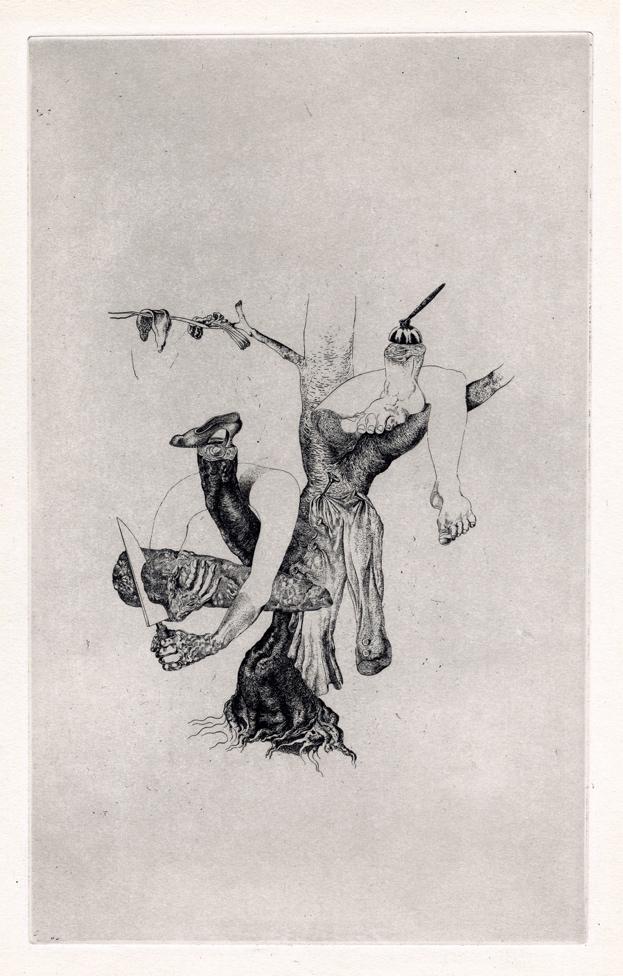
Salvador Dali ( Spanish: 1904 - 1989 )
Limbs on a Tree
Celluloid engraving, 1932 – 34; unsigned proof from before the reduction of the plates for publication in Les Chants de Maldorer (1934, Albert Skira); 11-5/8 x 7-3/16” platemark; printed by the artist on cream Arches watermarked wove paper. Ref.: Field 34-2. Inv. no. TOPE141. $9,500.
Around 1931 the publisher Albert Skira approached Salvador Dali about illustrating a new edition of Comte de Lautréamont's “Les Chants de Maldoror,” a long-form prose poem written between 1868-69 by de Lautréamont, nom de plume of writer Isidore Lucien Ducasse (French: 1846 - 1870). A violent, bizarre meditation on evil as told through the lens of a character named Maldoror, a figure of pure evil who has forsaken God, “Les Chants…” inspired countless Surrealists, from Dali to Joan Miro, Maz Ernst, Man Ray, and many others.
In all, Dali would produce forty-two images using experimental celluloid engraving on copper plate, possibly reworked with drypoint. These were then handed over to Roger Lacourière at his atelier in Paris, where he reduced the plate size for publication in the book. According to Dali's estate, it was Pablo Picasso who suggested Dali for the commission. Skira intended to publish between 200 and 300 copies, but due to financial strain, he was limited to 100 copies.
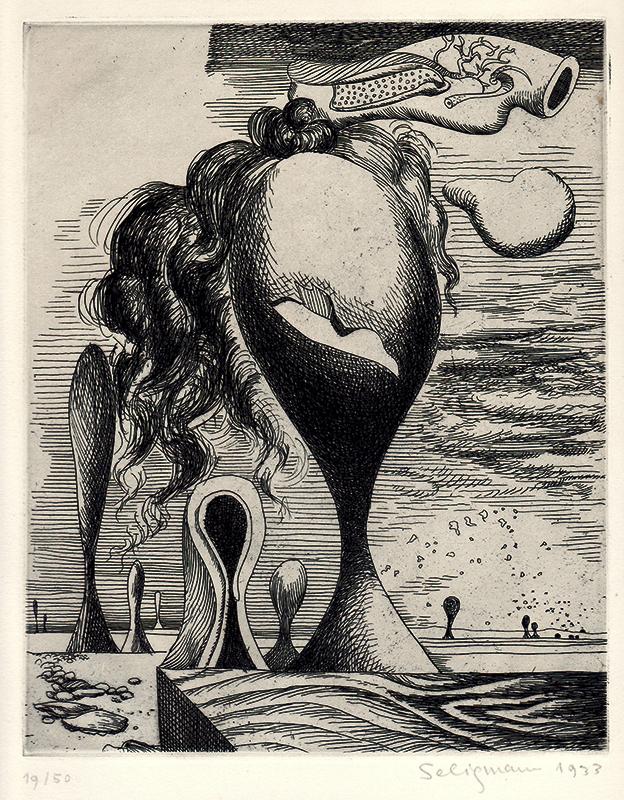
Kurt Seligmann ( Swiss/American: 1900 - 1962 )
Untitled – Plate 19 from ‘Album de 23 Gravures’
Etching, 1933, printed 1935; editioned 19/50; pencil signed; 9-3/4 x 17-13/16” platemark; printed by Imprimeur Tanneur, Paris, on antique-white Rives wove paper; published by Aux Editions G. Orobitz et Cie, Paris. Ref.: Serger 44; Mason 54. Inv. no. 20976. $3,000.
Seligmann created his first Surrealist etching in 1930, and was soon recognized for his biomorphic imagery by the French avant-garde. In 1935, he was approached by art critic and promoter of Abstract and Surrealist movements, Anatole Jakovski, to contribute to the portfolio Album de 23 Gravures, which included Kandinsky, Miro, Picasso, and other leading artists. Seligmann chose this work, done in 1933, for his contribution.
In 1937, he was accepted as a formal member of Andre Breton’s Surrealist group which included Jacques Hérold, Óscar Dominguez, Richard Oelze and Hans Bellmer. Breton deemed Seligmann the Surrealist authority on magic. Seligmann, like many artists during the depression era, had immersed himself in Spiritualism, especially the supernatural and occult. (Breton expelled him from the movement in 1943 over the meaning of a Tarot card.)

Louis Marcoussis ( Polish/French: 1883 - 1941 )
La Loreley
Etching, ca. 1934; editioned 2/10; state i/i; pencil signed; 3-13/16 x 1-7/16” platemark; printed by the artist on thick, antique-white wove. Ref.: Milet 152. Inv. no. 22039. $2,500.
“La Loreley (The Lorelei)” was the subject of two famous poems based on Clemes Brentano’s 1801 balled, “Zu Bacharach am Rheine,” one by German poet Heinrich Heine (1824) and the other by French poet Guillaume Apollinaire (1913). These tell of the vengeful siren, Lorelei, a woman accused of luring sailors to their deaths by singing to them from a rocky overhang on the Rhine River, nude, and combing her long golden hair. Louis Marcoussis addressed this story in more than one work. Here, he executes a Cubist composition of a giant seashell below water and the figure of Loreley/Lorelei combing her hair from her perch.
At the estimated time of this work’s creation, Marcoussis was working and exhibiting in the United States, having gained an international reputation for his Cubist/Surrealist imagery.
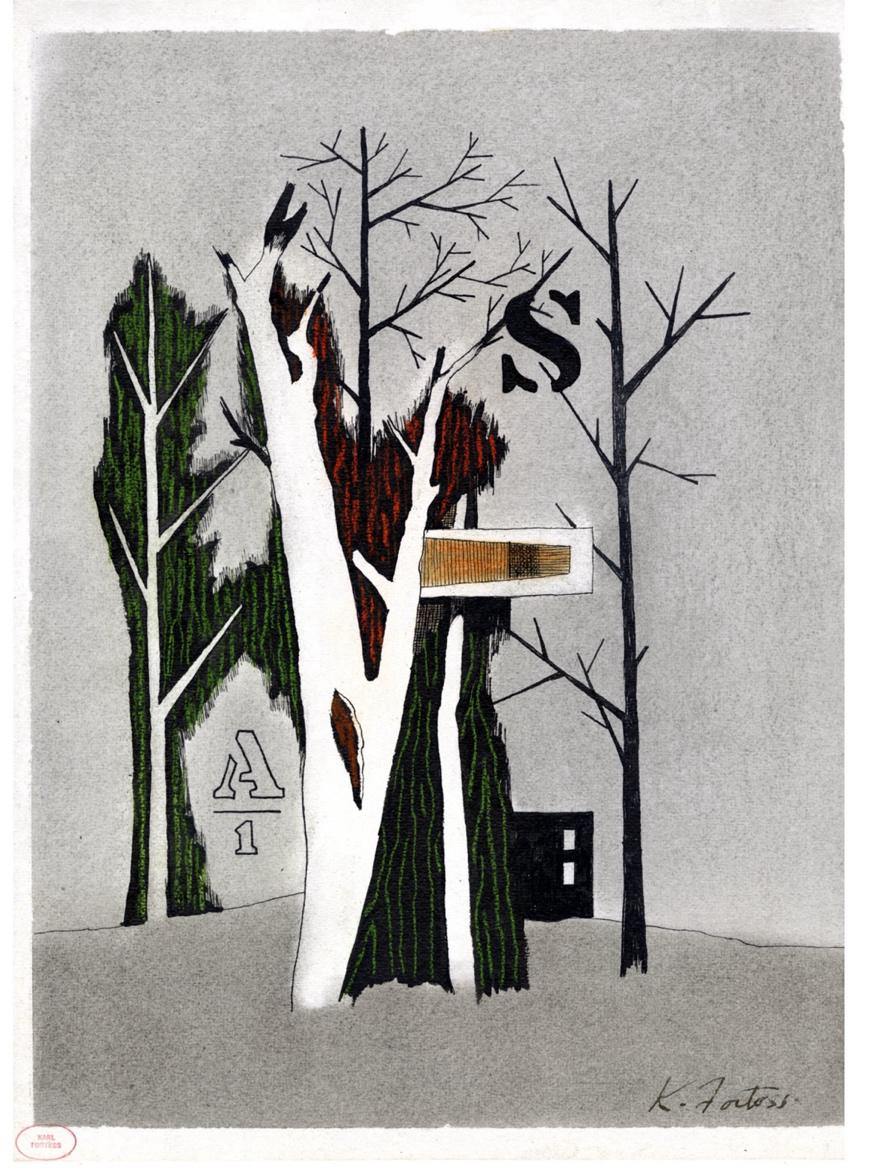
Karl Fortess ( American: 1907 - 1994 )
Untitled (surreal landscape)
Ink wash drawing with watercolor, ca. 1935; pigment signed; 16 x 12” image size. Inv. no. 9977. $1,200.
This composition was redrawn by Fortess as a color lithograph printed in an edition of 36 and included in a portfolio titled "Trees: 5 Lithographs", one of which was donated by Associated American Artists (AAA) to the Smithsonian Art Museum in 1967 (object number 1967.9.3). In his imagery, Fortess explored man’s effect on the landscape. He stated, “My concern is with a reality that is contrived from direct observation of man’s effect on the environment.”
Karl Fortess created this work in the mid 1930s, during the Great Depression. He presents a barren landscape, dominated by a tree stump and leafless trees. Within the composition he adds stenciled typography – including "A," "S," and "1".
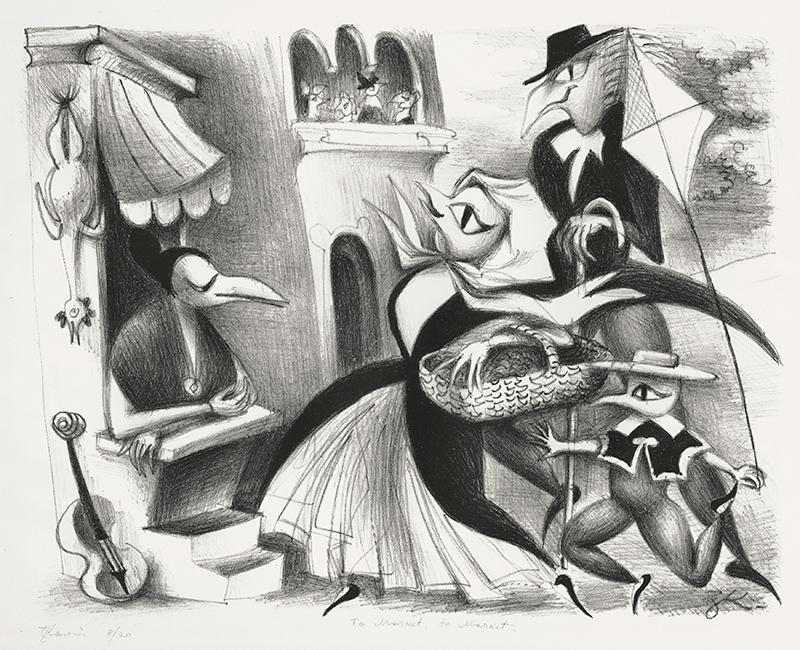
Zena Kavin ( American: 1912 - 2003 )
To Market, To Market
Lithograph, ca. 1935; editioned 8/20; pencil signed; 10-1/2 x 13-1/2” image size; printed by the artist on cream Warrens Olde Style wove paper. Ref.: illustrated p. 594, Emerging from the Shadows Vol. II, St. Gaudens, 2015. Inv. no. 7736. $400.
While she has no formal association with the Surrealist movement, San Francisco Bay Area-based Kavin’s early work, including To Market to Market, exhibits the genre’s abandonment of formal subject matter in favor of the imagination. She draws strange, darkly fantastic worlds, populated with animal-headed figures performing human activities with abandon.
Her formal art studies began at the California School of Fine Arts before she traveled to Moscow to study under Russian avant-garde painter and printmaker Aleksei Kravchenko. She later became an illustrator and comic artist, frequently working in collaboration with her husband, Joe Cornin
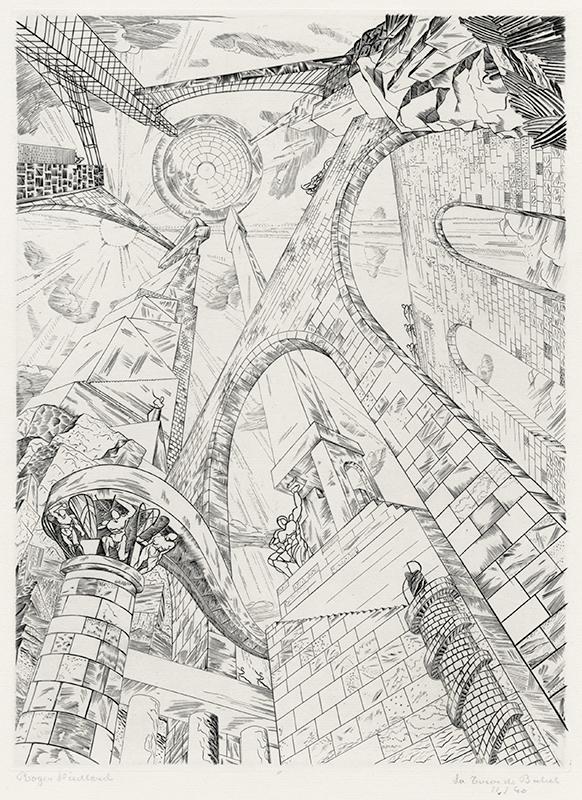
Roger Vieillard ( French: 1907 - 1989 )
Tour de Babel (Architecture II)
Engraving, 1935; editioned 11/40; pencil signed; 14-7/8 x 10-5/8” platemark; printed by the artist at Atelier 17 on cream ivory Vidalon France laid paper. Ref.: Hacker 21. Ex collection Cathal O’Toole. Inv. no. 23925. $3,800.
Vieillard was inspired to do this print after walking beneath the Eiffel Tower. He drew the tower from the inside as it soars to the sky, fragile architectural elements supporting each other. The image brings to mind Piranesi's Carceri series and Escher's strange, interwoven structures.
Hacker notes about this image on page 12: "Tour de Babel is an invention of which Piranesi himself would have been envious, for nothing since the Carceri even approximates to this dazzling, vertiginous tour de force...the Tower of Babel depicted from the inside, looking upward....A nice detail is added by a minute 'penseur', seated on a pilaster at top left 'contemplating the absurdity of it all'.
Vieillard's work was represented in the important 1944 exhibition "Hayter and Studio 17," mounted at The Museum of Modern Art in New York. The exhibition included sixty prints by thirty-two artists from twelve nations.
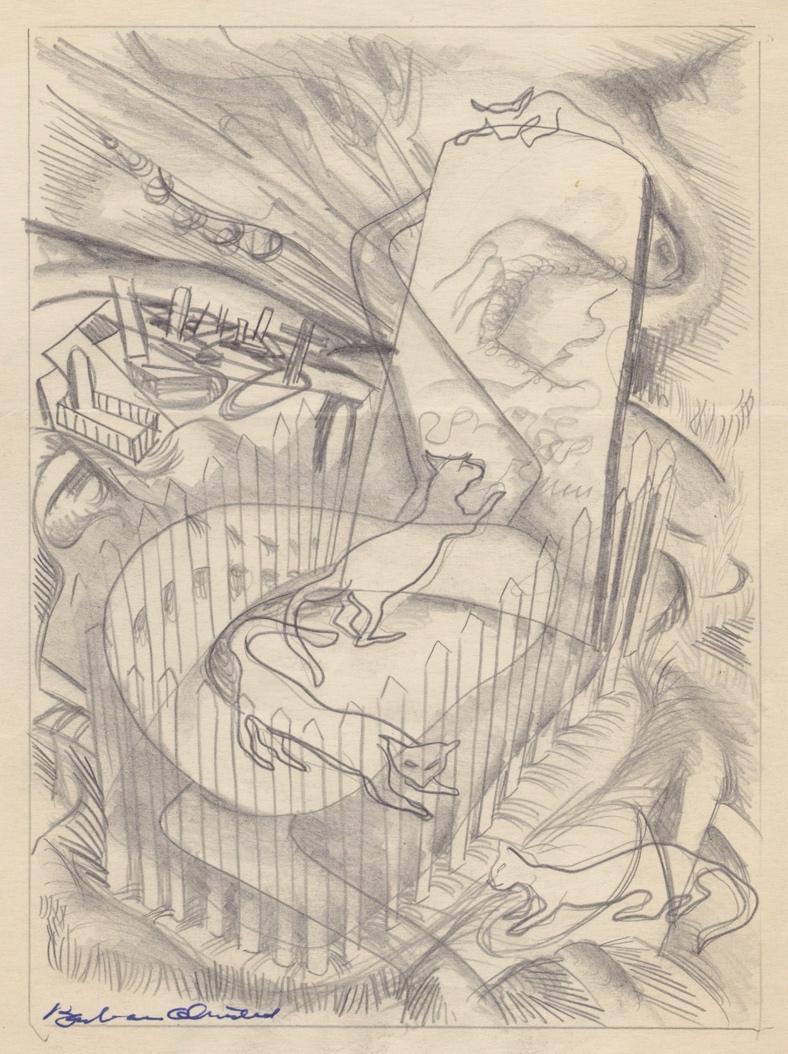
Barbara Olmsted ( American: 1915 - 2013 )
Untitled (cats in a graveyard)
Graphite drawing, ca. 1936; ink signed; 7-1/2 x 5-1/2" image size; on thin, antiquewhite wove paper. Inv. no. 20019. $1,500.
A surreal and humorous depiction of cats playing and lounging in a graveyard, translucent pathways that seem to emerge from the ground and continue skyward suggesting the cats’ existence between the living and the dead. This appears to have been a preparatory sketch for a print that never materialized. Barbara Olmsted’s blue ink signature in the lower left signifies that the drawing itself was later approved by her as a stand-alone work.
Olmsted’s 1930s work reflects the changing tides of modern art in the early half of the 20th century. The bulk of her oeuvre was rooted in surrealism and evolved into nonrepresentational abstract expressionism. One hallmark of this path is her use of automatic line, attributed in some respects to Atelier 17 founder Stanley William Hayter, under whom she studied during the workshop’s original iteration in Paris. At work in this piece is the influence of both genres and the stylistic changes emerging in the experimental art world.
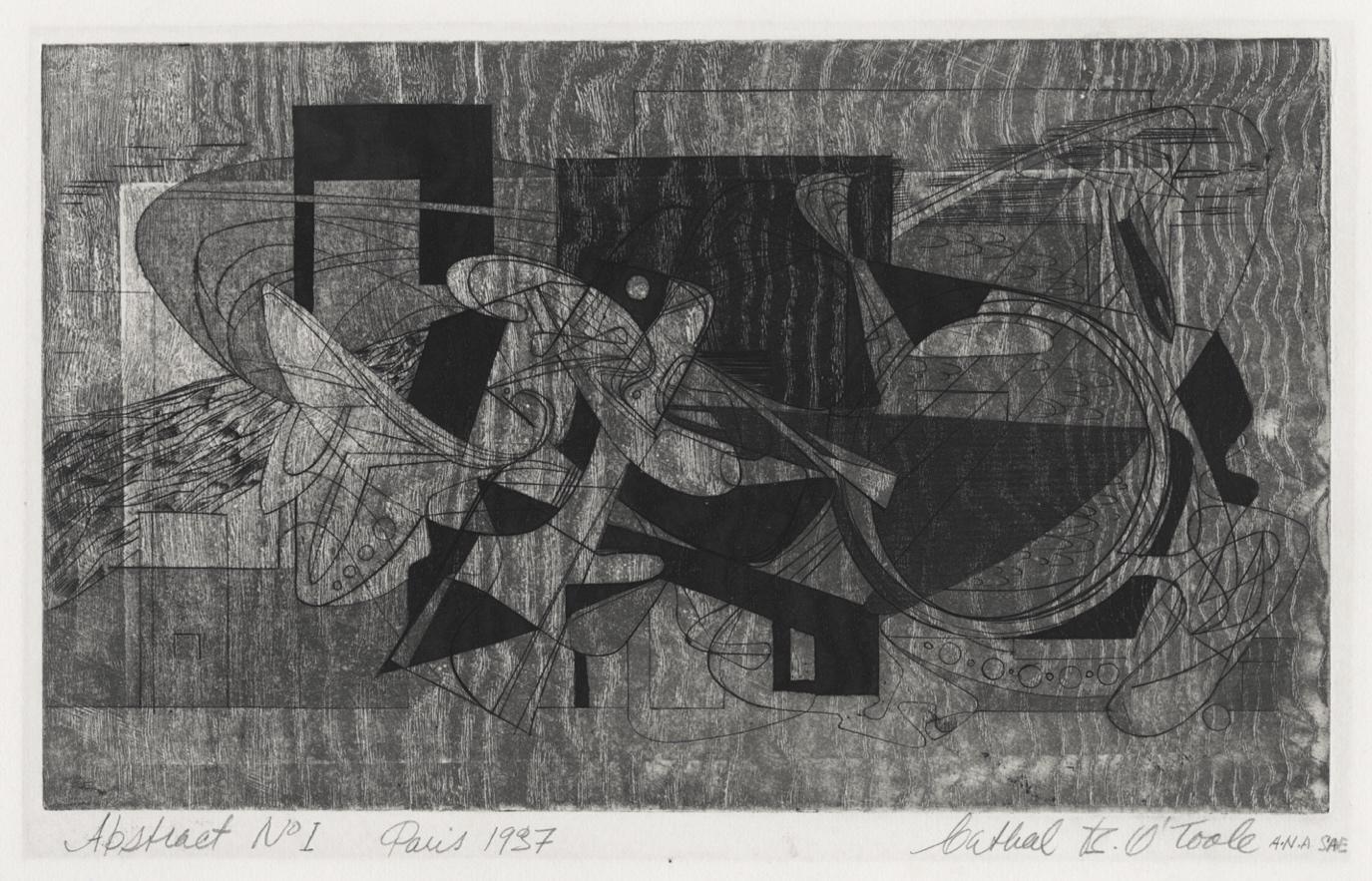
Cathal O’Toole ( Irish/American: 1904 - 1991 )
Abstract No. I
Mixed technique intaglio, 1937; proof (not formally editioned); pencil signed; 6-1/16 x 10-3/16" platemark; printed by the artist at Atelier 17 on cream wove paper. Inv. no. 24365. $2,000.
Irish born Cathal O'Toole moved to the U.S. in 1925 and studied printmaking at the Art Students League in New York. In 1934, he spent three years studying in Europe on a Pulitzer award and spent time studying with Stanley William Hayter at Atelier 17 in Paris where printmakers from around the world assembled and were doing experimental work.
Abstract No 1, done in 1937, before Atelier 17 moved from Paris to the United States, is the result of working with a number of experimental intaglio techniques such as soft-ground etching, impressed with the transferred grain from a wood-block, engraving, etching, and aquatint. A fine example of what Atelier 17 represented.
O'Toole signed this impression indicating his membership in two art organizations: “A.N.A” (Associate of the National Academy) and "S.A.E". (Society of American Etchers), which he squeezed in later behind his signature. He discusses his methods in an article titled "While There's Copper There's Hope" in the magazine American Artist, June 1942, Vol. 6 Issue 6, p 24.
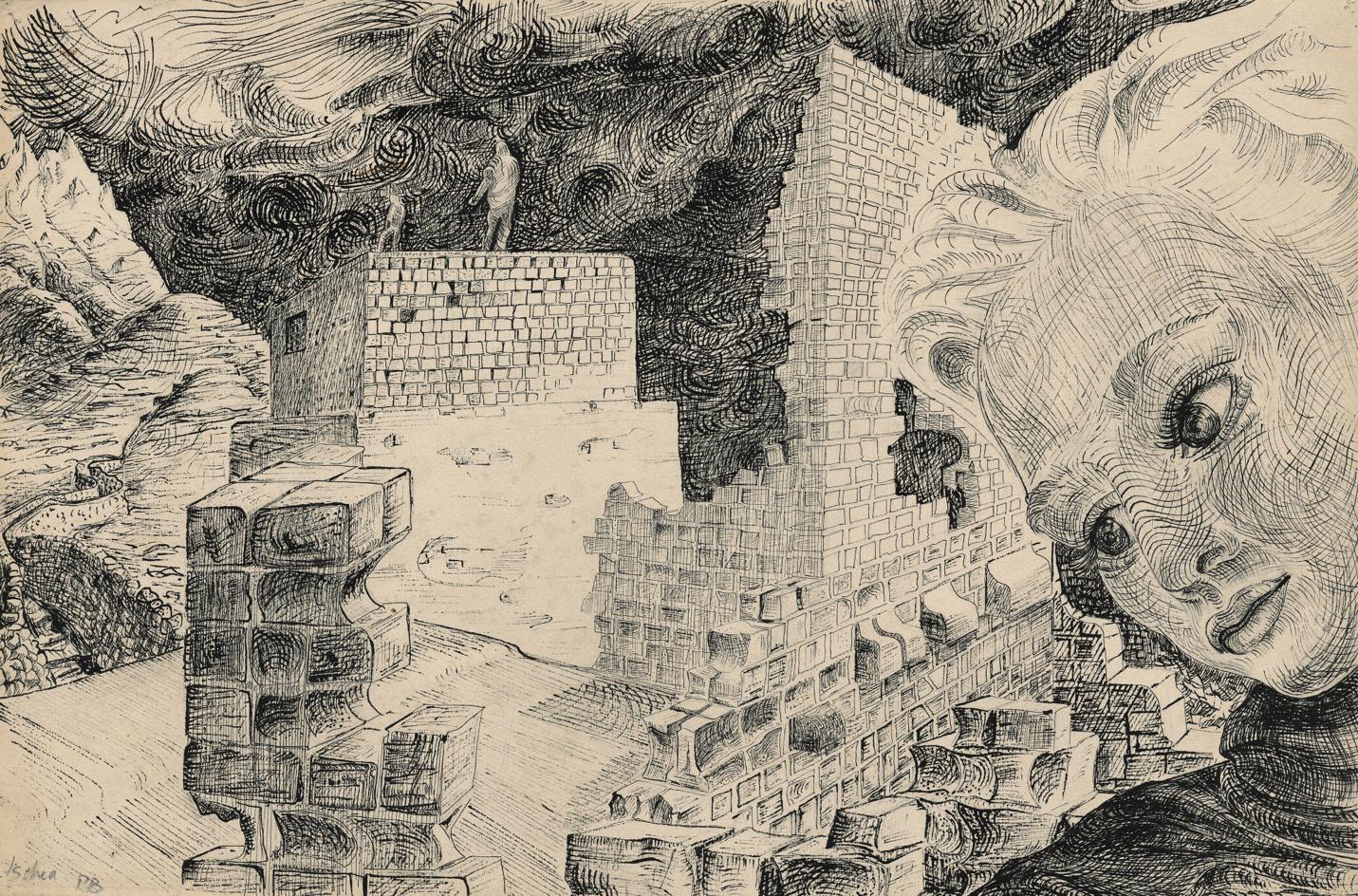
Pamela Boden ( American: 1905 - 1981 )
Ischia
Ink and charcoal drawing, ca. 1939; pencil initialed; 13-1/2 x 20-1/2" image size; signed; on dark buff wove paper. Inv. no. 21691. $1,000.
This surreal drawing by Pamela Boden appears to be a self-portrait, her ¾ profile wedged into the right side of the composition, overlooking structures threatened by stormy skies, which two figures appear to be watching from atop the central structure. She named this Surrealist work for the Italian volcanic island of Ischia, located in the Gulf of Naples
Boden lived and exhibited in Paris in the 1930s, where she was associated with the Surrealists and Dadaists. She was a close friend of composers Peggy Glanville-Hicks and Stanley Bate (to whom she was briefly married). After moving to America in 1945, Boden began her U.S. exhibition career at Peggy Guggenheim’s Art of This Century Gallery, showing her sculptures alongside Clyfford Still’s paintings in 1946. She eventually settled in California.
Despite her extraordinary work and numerous exhibitions, Boden died before she received proper recognition for her contribution to Surrealism and Abstract Expressionism.
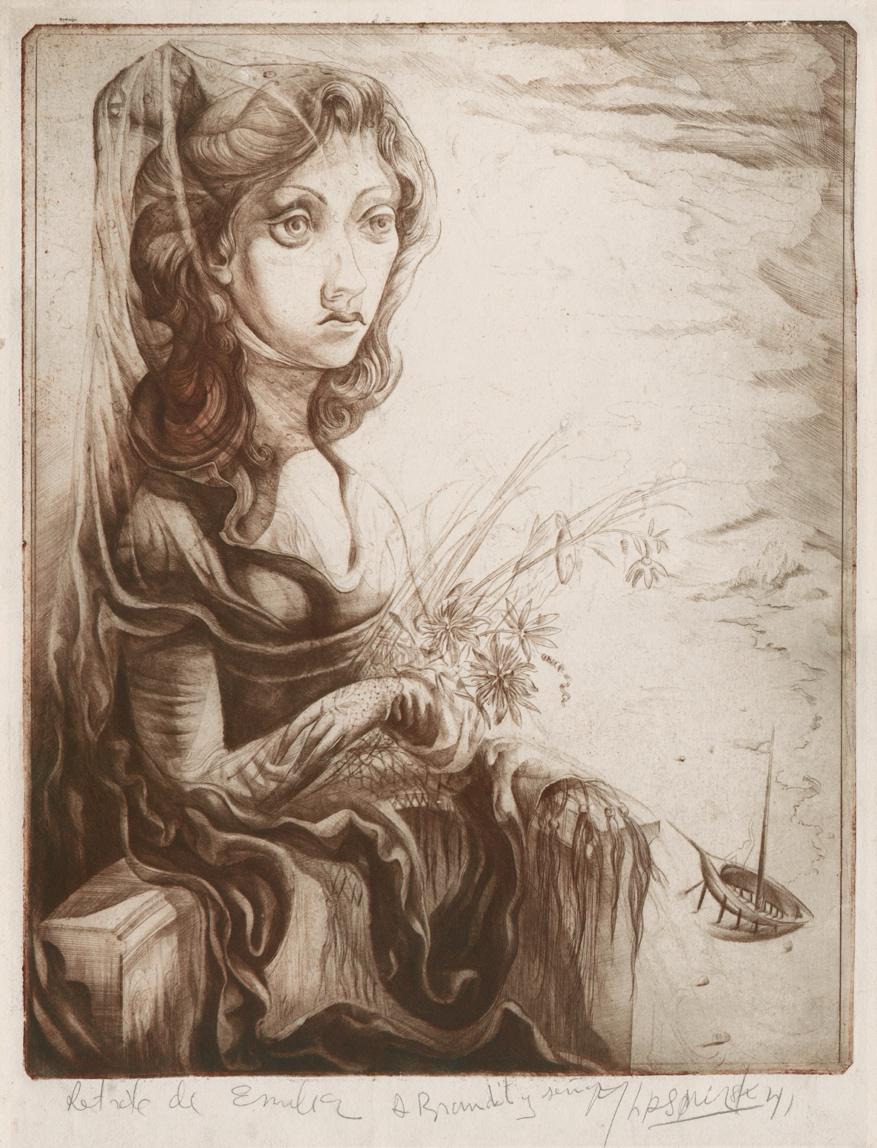
Mauricio Lasansky ( Argentinian/American: 1914 - 2012 )
Retrato de Emilia
Drypoint, 1941; rare proof from a total of about ten variant impressions; pencil signed; 15-3/4 x 12-3/8” platemark; printed by the artist on heavy, antique-white wove paper. Ref.: Thein/Lasansky 47; Zigrosser 47. Inv. no. 22387. $7,500.
A scarce, Surrealist portrait of Lasansky’s wife, Emilia, depicted in a Renaissance garb, holding a bouquet of wildflowers. In the background appears an unfinished drydocked boat, on the what might be a sandy shoreline; Emilia’s superimposed figure dwarfs the little boat, as she stares into the distance beyond the viewer. The plate was printed using a dark sepia ink.
Portrait of Emilia was done in Argentina in 1941, two years before Mauricio left for New York to work at Atelier 17, and is pencil dedicated "A Brandt y senor". A.M. Brandt was a colleague of Lasansky's at the Free Arts School in Villa Maria, Cordoba, Argentina. After Atelier 17, Lasansky was hired to head and transform the printmaking department at the University of Iowa.
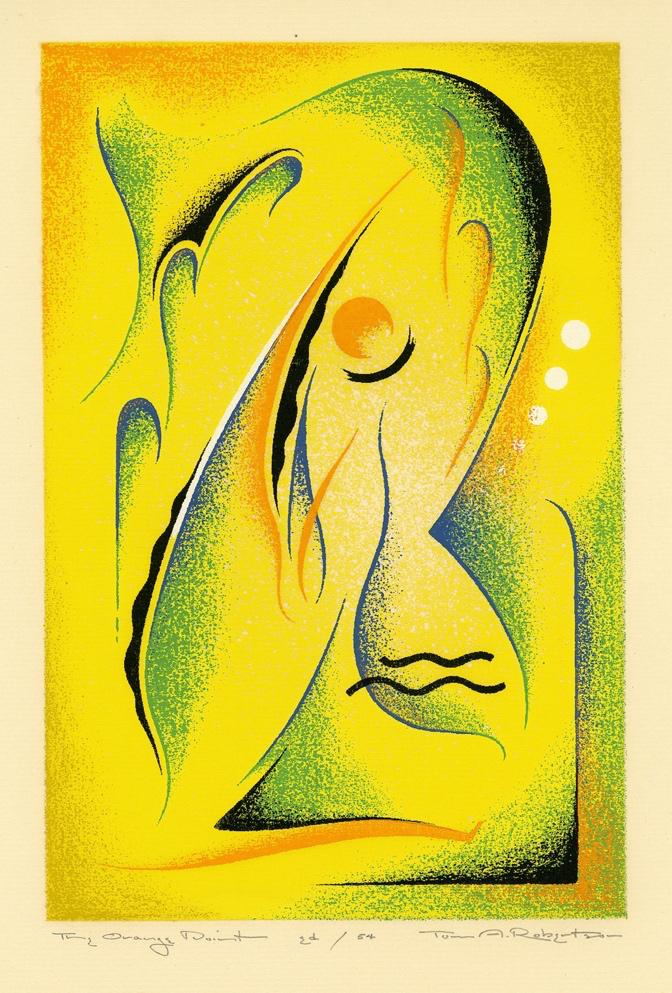
Thomas Arthur Robertson ( American: 1911 - 1976 )
The Orange Point
Serigraph, 1941; editioned “Ed/54”; pencil signed; 10-1/2 x 7” image size; printed by the artist cream Albion laid paper. Inv. no. QUHI115. $900.
The Orange Point was among several screenprints Robertson created after his return to his home state of Arkansas. At the time, Surrealism and Abstract Expressionism were not widely embraced in the American South, but Robertson’s work was met with critical praise nonetheless when he exhibited these screenprints at the Delgado Museum (now the New Orleans Museum of Art) in 1941.
Another impression of The Orange Point is illustrated in color and discussed on pages 148 - 149 in A Spectrum of Innovation - Color in American Printmaking 1890-1960 by David Acton, (1990, Worcester Art Museum). Acton writes: "The artist employed simple technical means to achieve interesting spatial and coloristic effects in the print, modeling the surface of the yellow field with several colors rather than placing forms before it. The design is primarily linear, however, and the surface contours do not circumscribe forms but instead define ridges, like crests of hills on a topographical chart. The modeling on both sides of these contour lines create spatial ambiguity, the swirling curves reminiscent of markings on a weather map.”
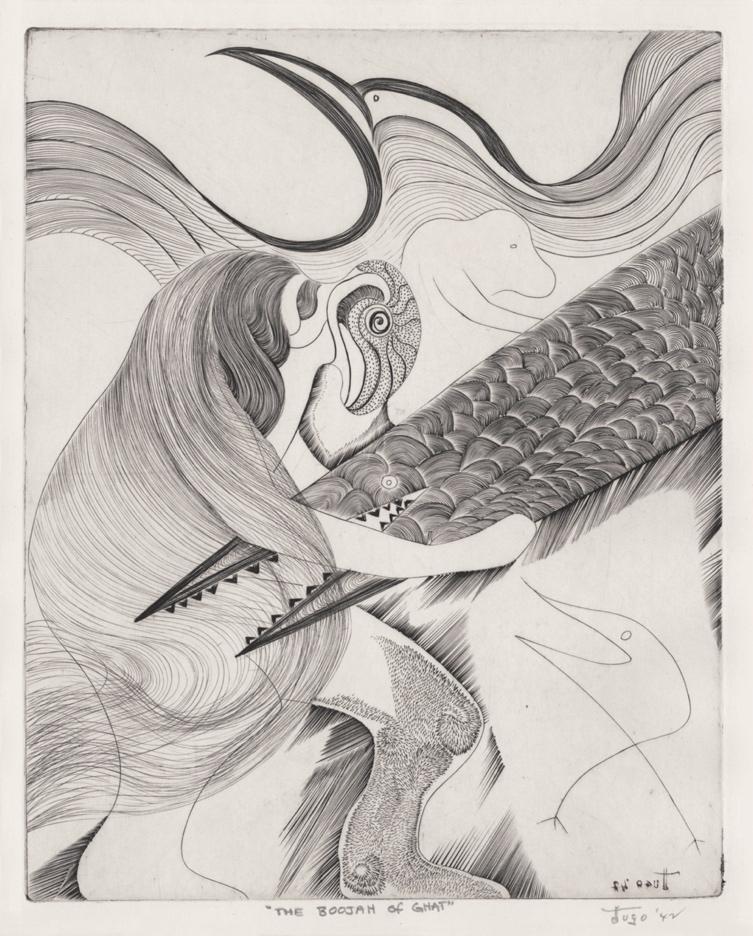
Ian Hugo ( American: 1898 - 1985 )
The Boojah of Ghat
Engraving, 1942; unnumbered proof (total of around twenty-nine impressions); pencil signed; 10 x 7-7/8" platemark; printed by the artist at Atelier 17 on antique-white wove paper. Inv. no. 19496. $500.
Ian Hugo, born Hugh Parker Guiler, was one the earliest printmakers to help re-establish Stanley William Hayter’s Parisian workshop, Atelier 17, in New York as World War II raged in Europe. Hugo and his wife, writer Anaïs Nin, met Hayter Paris before they fled to the U.S. in 1939.
Due to the controversial nature of her work, Nin was having a difficult time finding publishers and decided to publish her work on her own, with Hugo’s financial help. In the meantime, Hugo pursued engraving at Atelier 17 in New York, after Nin commissioned him to create illustrations for her books and essays. This led to an extraordinarily prolific, if brief, output on Hugo’s behalf.
In this image, a Surrealist creature embraces a large, sharp-toothed fish, while suggestions of both waves and a large bird spreading its wings stretches through the upper quarter of the sheet. Hugo engraved this image directly on the copper plate and the ink stands up from the surface of the paper.
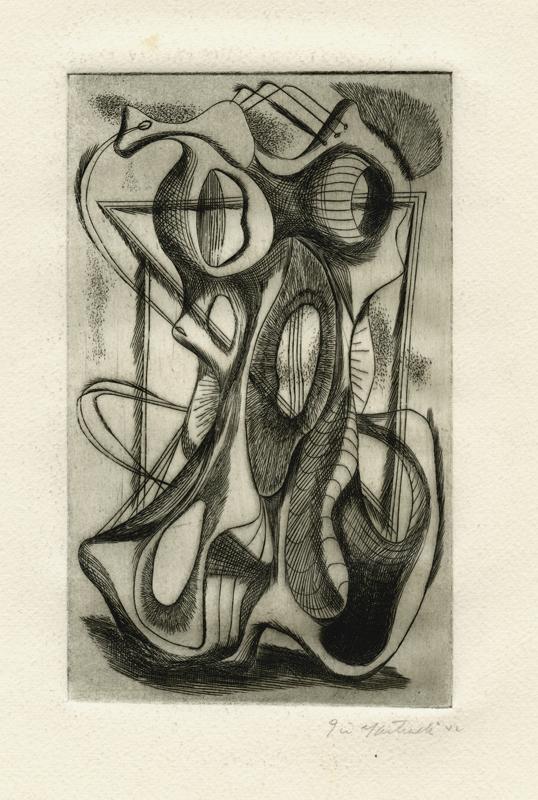
Ezio Martinelli ( American: 19 13 - 1981 )
Untitled (surreal structure)
Etching and engraving, 1942; edition not stated; pencil signed; 5-13/16 x 3-9/16" platemark; printed by the artist on toothy, ivory wove paper. Inv. no. 16134. $500.
Ezio Martinelli studied sculpture under Robert Ingersoll Aitken at the Art Students League in New York during his years in the WPA. This would prove to be pivotal time for him, leading to his continued interest in spatial dynamics in all mediums, whether three-dimensional or on a flat plane. He furthered his interest in nonrepresentational work once he began studying with Hayter at Atelier 17 in New York. In this Surrealist intaglio, a biomorphic shape appears to emerge from the plate, almost as if the viewer could reach out and touch it.
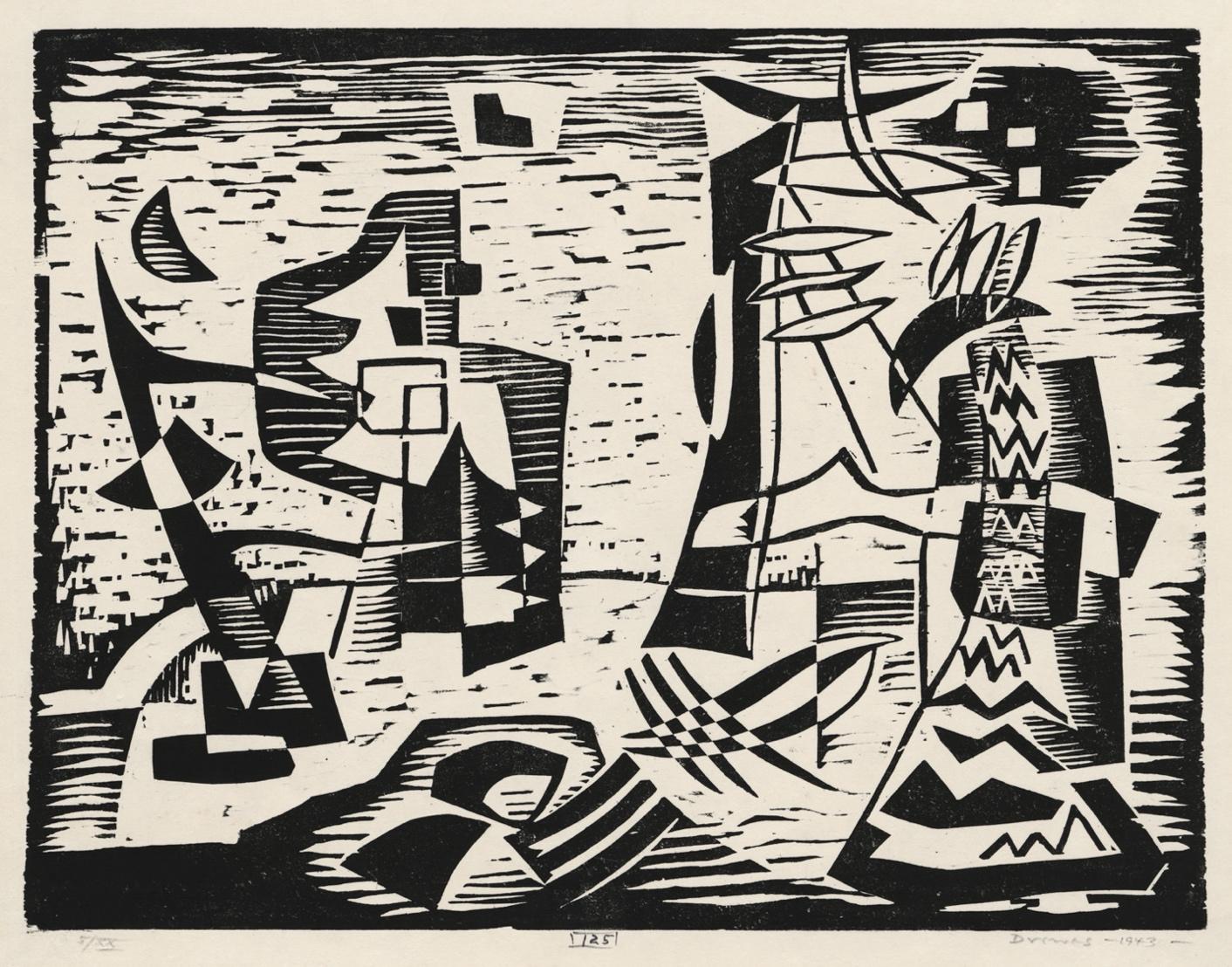
Werner Drewes ( American: 1899 - 1985 )
Indian Motif
Woodcut, 1943/44; editioned 5/XX; pencil signed; 11-3/4 x 15" image size; printed by the artist on fibrous, ivory Japanese laid paper. Ref.: Rose 113. Inv. no. MCT209. $2,200.
German-born artist Werner Drewes studied at the Bauhaus with Paul Klee, Oskar Schlemmer, Wassily Kandinsky, and Laszlo Moholy-Nagy. After immigrating to the United States, Drewes worked in the WPA and helped found the American Abstract Artists group In 1944, he studied printmaking with Stanley William Hayter at Atelier 17 in New York. Indian Motif was part of an eight-image series of abstracted woodcuts Drewes did between 1943 and 1944. Drewes referred to Native American symbols for his woodcut Indian Motifs. He printed this impression, in black, in an edition of twenty. He printed a second state in black and green, also in an edition of twenty. He then printed a number of proofs that he colored with yellow, orange, ocher, and gray, using a brush on the woodblock. Impressions vary in colors. The blocks were destroyed.
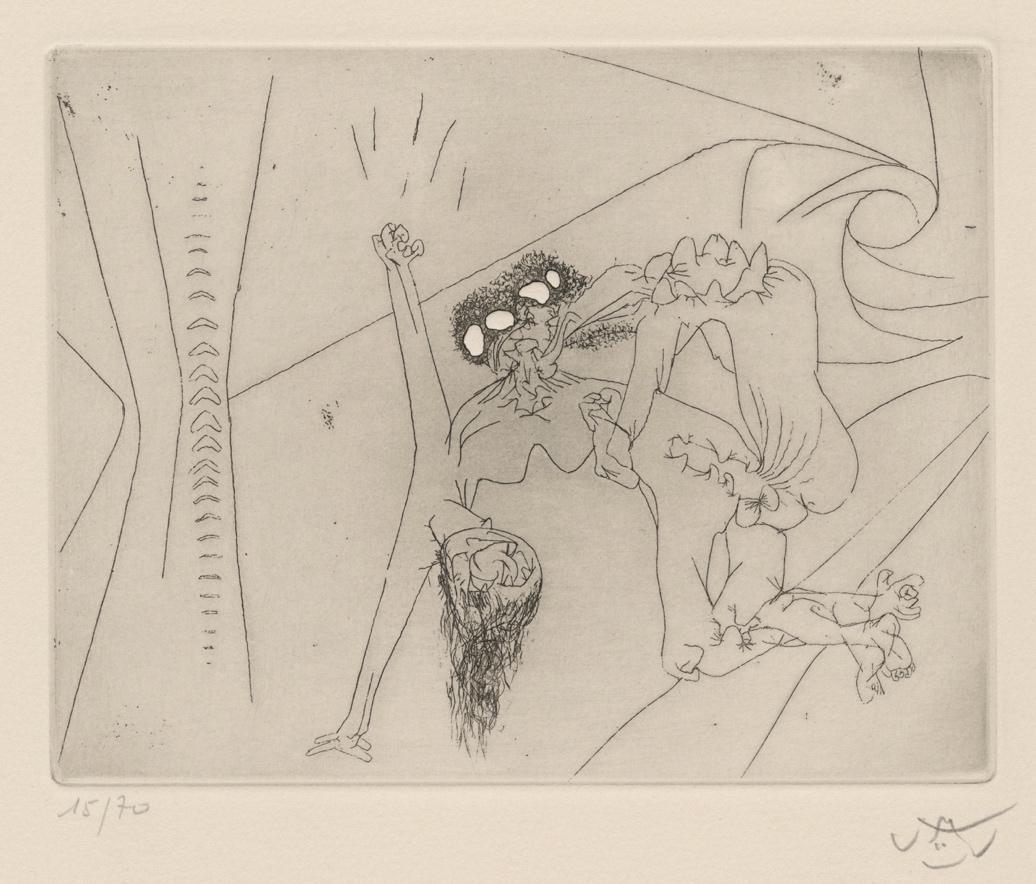
Roberto Sebastian Matta ( Chilean: 1911 - 2002 )
Untitled - from The New School Portfolio of ten etchings
Copperplate etching, 1943/printed 1979; editioned 15/70 (the only published edition; only five proofs from 1943 before the plate was lost until 1979); pencil signed; 5-15/16 x 7-5/8” platemark; printed and published by Éditions Sabatier-Satié, Paris, on ivory Arches wove. (NOTE: This image is not included in the catalogue raisonné as the plate was missing at the time of publication.) Inv. no. 24160. $900.
Roberto Matta, a Chilean native who had first moved to Europe to expand his studies in architecture in 1933, was intrigued by the Surrealist movement and abandoned his original plan, instead devoting himself to painting. By the time he entered Atelier 17 in 1943, he had established himself as a leading Surrealist, and one of the very few Chilean Modernists to exhibit in the broader art world at the time.
“The New School” references the New York institution where Atelier 17 was temporarily located as World War II raged in Europe. While there, Matta was approached by the art collector Bernard Reis to create a suite of etchings. Matta’s ensuing etchings of Surrealist erotic images remained unpublished due to their explicit nature. In all, only around five trial proofs were printed of each plate and given to a handful of collectors, including Reis; the plates then went into storage and were eventually split up, with seven remaining in the U S and three being sent to Paris. In 1979, these were published in an edition of 70 by the artist and Roland Sabatier.
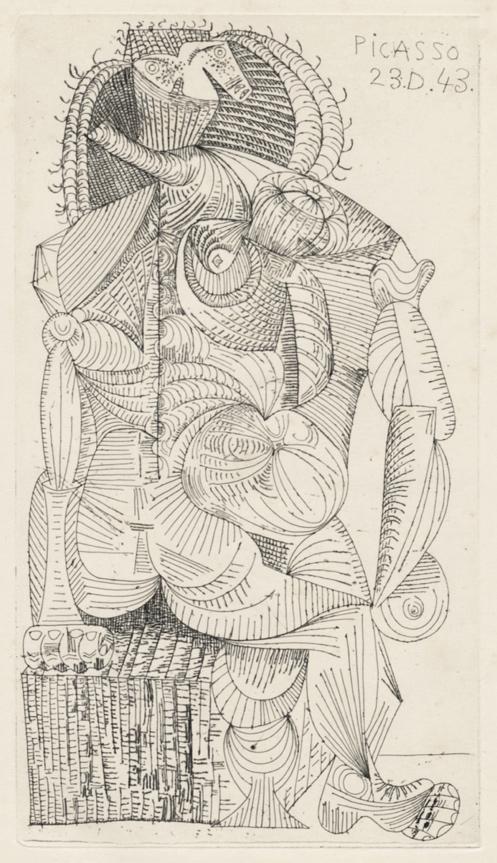
Pablo Picasso ( Spanish: 1881 - 1973 )
Contrée – Robert Desnos, Eau-forte de Picasso (Femme Assise –Dora Maar) (book with looseleaf frontispiece)
Etching (frontispiece for the book, loose, as published), 1943; book is numbered 106/200 on the colophon; signed in the plate, upper right; 9-5/8 x 5-13/16” platemark; etching printed by Lacourière; book printed by Durand; on ivory Papeterie Lafuma pur fil velin; published by Robert J. Godet, Paris. Ref.: etching: Bloch 362; Baer 689 B b; Cramer 39; book: Horodisch D 18. Inv. no. TOPE128. $7,500.
This softcover quarto book has retained its original glassine dust wraps embossed with spiderwebs. An original etching by Pablo Picasso, Femme Assise - Dora Maar- a Cubist portrait of his lover - serves as the loose frontispiece which has then been lithographically reproduced in fragments throughout the book.
A book of twenty-five typeset poems by French Surrealist Robert Desnos (1900–1945), Contrée addresses Desnons’ experience during the German occupation of France and his memories of life before the war. An active member of the French Resistance, he was arrested by the Gestapo in February of 1945 - less than a year after the book was published - and he died of typhoid in the Terezin concentration camp in Czechoslovakia, just one month after the liberation of the camp, but before he could be transferred out. Contrée is dedicated to his wife, Lucie “Youki” Basnos.
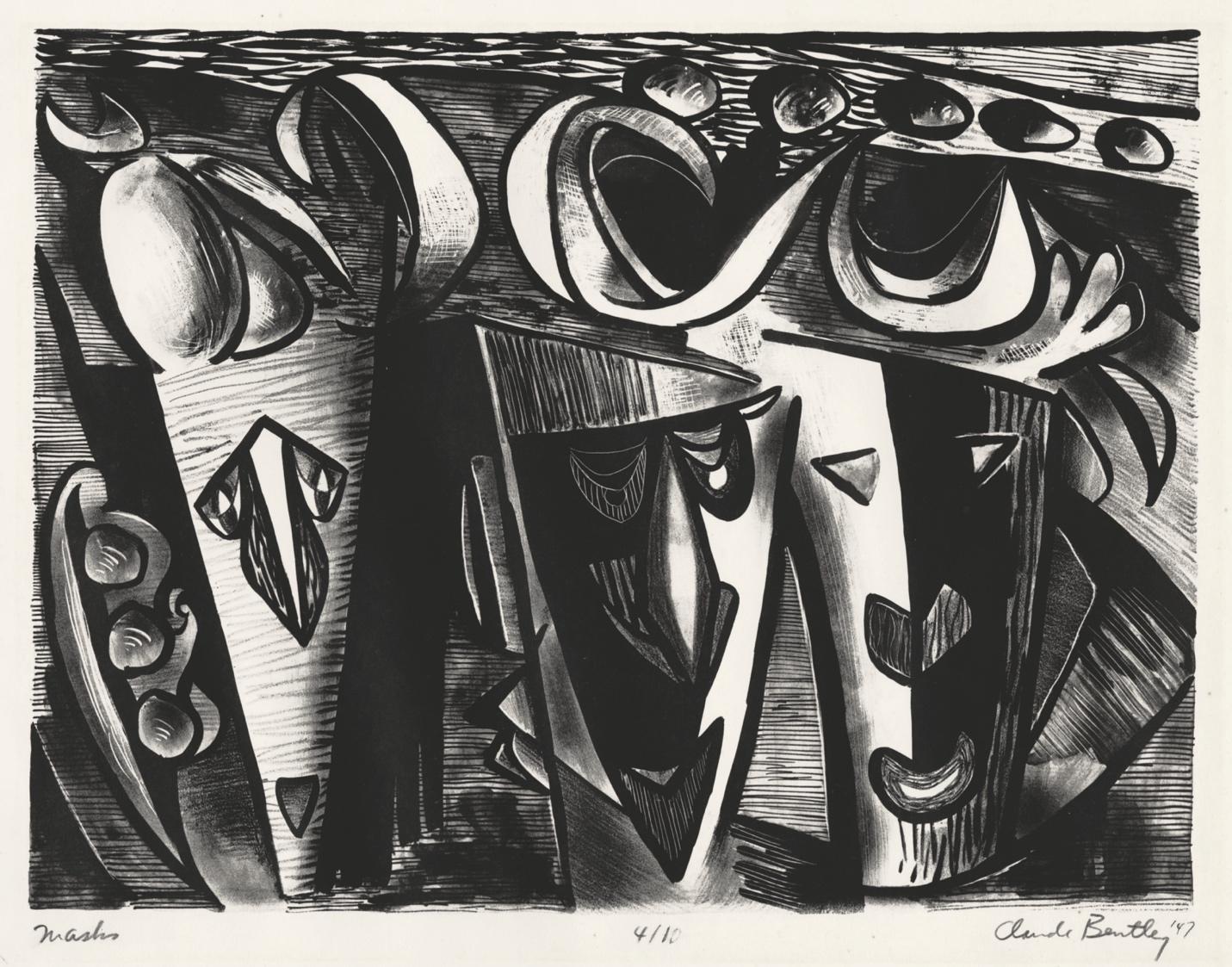
Masks
Lithograph, 1947; editioned 4/10; pencil signed; 10-1/4 x 13-11/16” image size; printed by the artist on thick cream wove paper. Inv. no. 14970. $750.
Claude Bentley’s work was greatly inspired by his time in North Africa while on his tour of duty during World War II. When he returned, his interest in the art of ancient cultures led him to study Pre-Columbian, Mesoamerican, and Oceanic sculpture and masks. Meanwhile, the burgeoning American mid-century Modernist style, reflecting an enthusiastic global connection in the immediate postwar era, found foothold in the imaginations of artists across the nation.
Masks walks the line between the Surreal and the Abstract, reflecting the exploratory time between Bentley’s formal art education and his eventual pursuit of fully non-representational imagery.
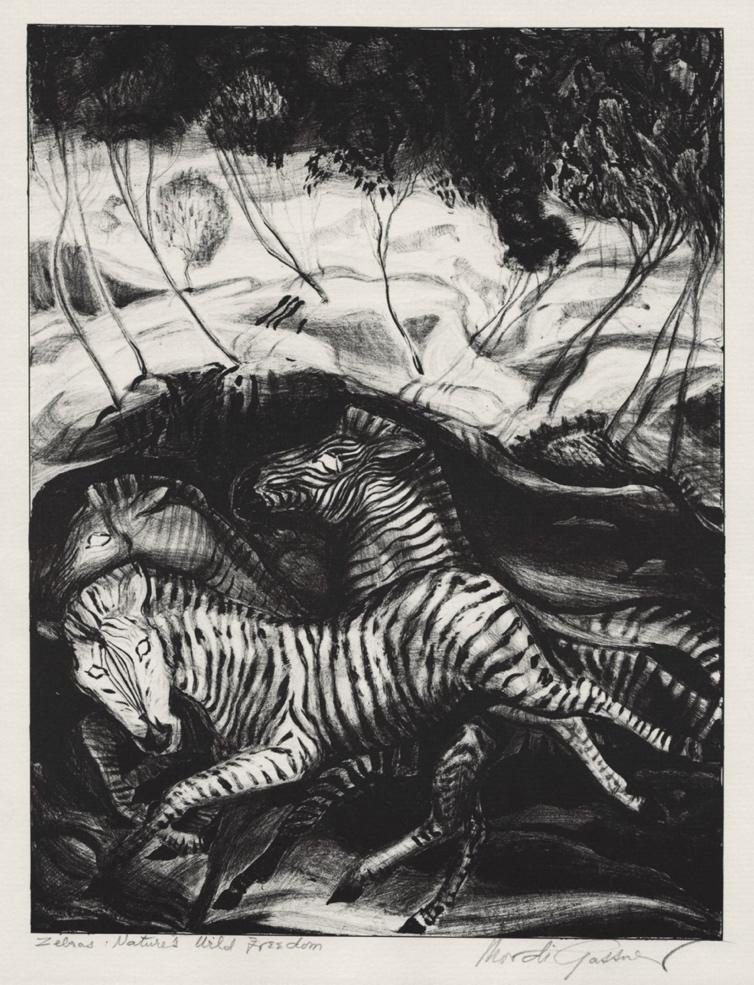
Mordi Gassner ( American: 1899 - 1995 )
Zebras: Nature’s Wild Freedom
Lithograph, 1947; edition not stated; pencil signed; 12 x 9” image size; printed by the artist on heavy ivory wove paper. Inv. no. 21267. $450.
Mordi Gassner’s career was wildly varied and adventurous. Initially teaching himself how to draw, he was encouraged to attend the New York School of Fine and Applied Art (later the Parsons School of Design) after high school. Graduating in 1919, he then opened a studio in Brooklyn. Several fortuitous connections led to a major commission by couture furrier Otto Kahn, followed by jobs in Hollywood as an art director and consultant for Douglas Fairbanks and Cecil DeMille, and in 1938 he was awarded two Guggenheim Fellowships to live and study in Florence, Italy.
During the Depression, Gassner worked for the WPA as a muralist. Following World War II, his career expanded to include teaching at the New School of Social Research and the Art Students League, both in New York. Despite these successes, he unfortunately died in near obscurity, with the majority of his work being sent to an undisclosed landfill upon his death in 1995.
While not strictly Surrealist, Zebras nevertheless intrigues, achieving the difficult task of creating a scene both haunting and joyous without ever dictating what the viewer is meant to feel.
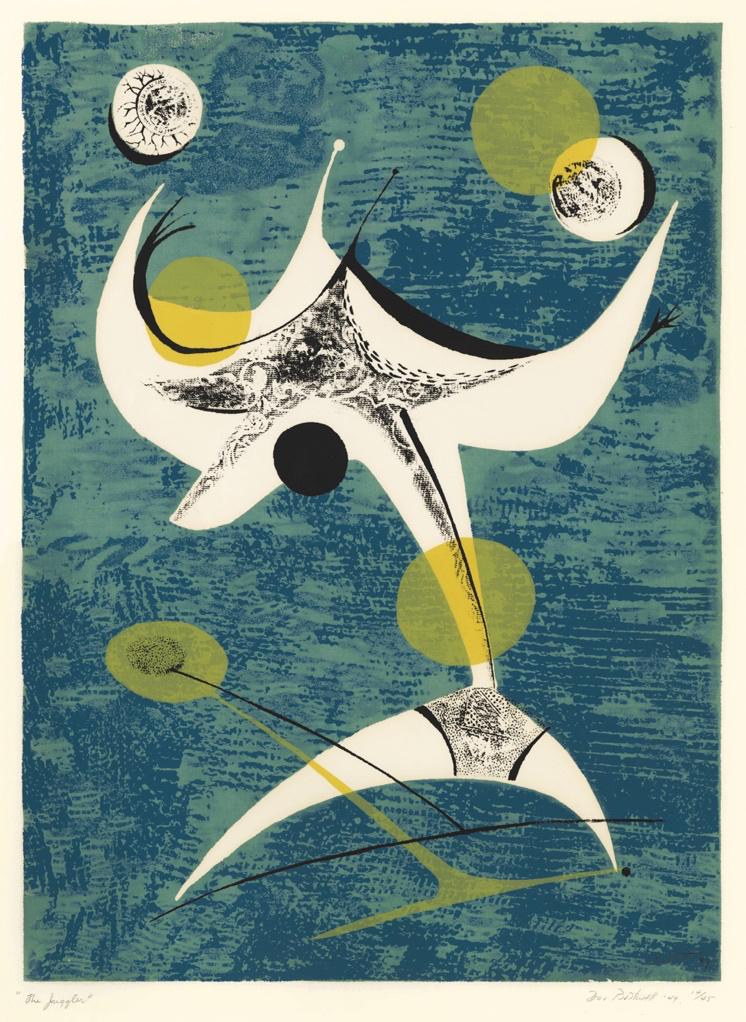
Dorr Bothwell ( American: 1902 - 2000 )
The Juggler
Serigraph, 1949; editioned 14/45; pencil signed; 19-1/16 x 14” image size; printed by the artist on ivory wove paper. Inv. no. ABMM267. $1,000.
Dorr Bothwell was influenced by the Surrealists, Arthur Dow's theory of Notan, and the design concepts of Rudolph Schaeffer. She wrote her own book, Notan: The Dark-Light Principal of Design.' This color screenprint is an excellent example of her work from the late 1940s. An abstracted “juggler,” surrounded by a number of globes, tossed in the air. The composition has tension and balance, yet conveys a sense of movement, stopped in time. The light figure is set against a modulated dark background.
Bothwell wrote: Everywhere we look we see this principle in action. Trees are not silhouetted against blank air, but hold blue patterns between their leaves with the branches frame living shapes of sky. We delight in the openings between the leaves of a plant or the spokes of the wheel. this endless exchange between form and space excites us. Once more we feel in touch with our world; our aesthetic sense is being fed and we are comforted
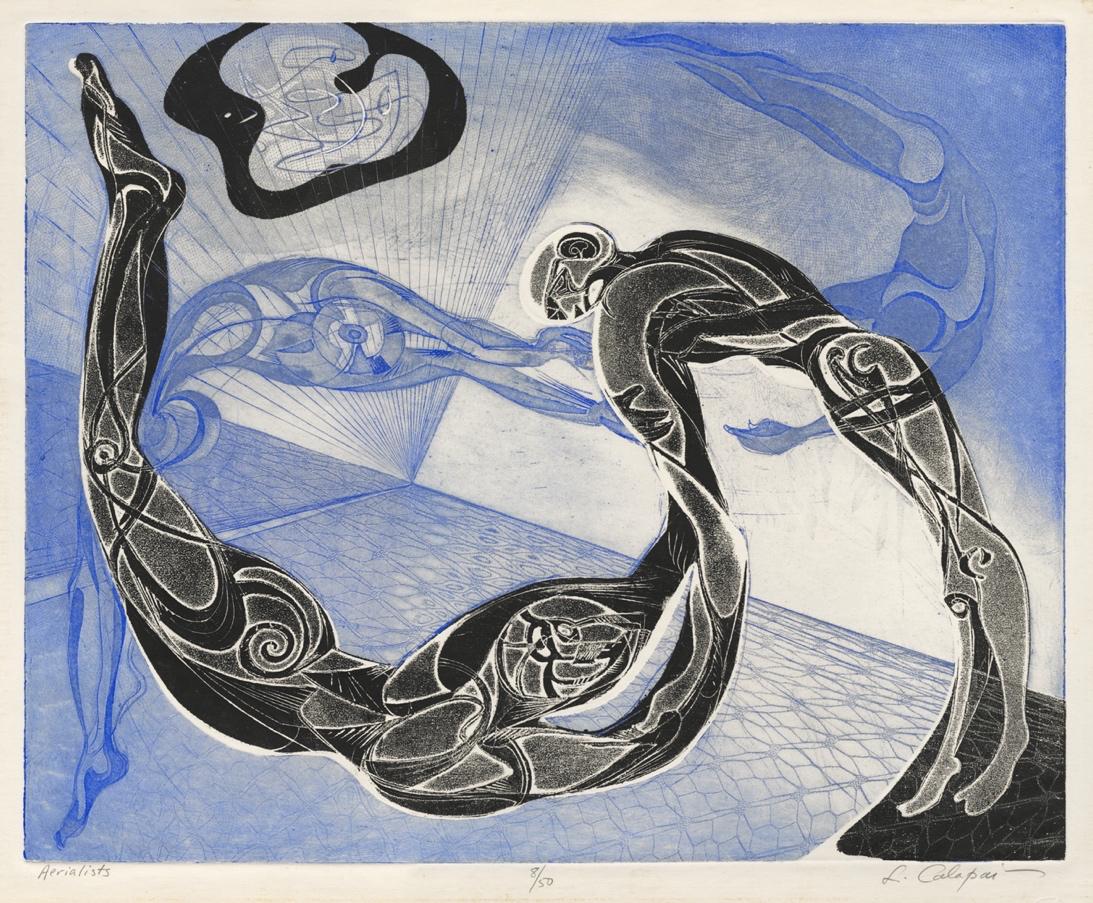
Aerialists
Aquatint, collagraph, and etching printed in two colors, 1949; editioned 8/50; pencil signed; 13-1/2 x 16-13/16” platemark; printed by the artist at Atelier 17 (artist’s chop in lower right margin) on cream BFK Rives wove paper. Ref.: Maurice, cat. no. 5; Aaron Galleries, illus. p. 15. Inv. no. 24175. $2,500.
Letterio Calapai was working at Stanley William Hayter’s Atelier 17 in New York in 1949, the year that this color intaglio was created. The hallmarks of the experimental workshop and the influence of Hayter are all evident in this image of four surreal figures twisting through the air, a delicate, expansive interior designed with a series of sharp, linear patterns.
In his introduction for Letterio Calapai: a 50 Year Retrospective (1934-1984), Alfred P. Maurice wrote:..Calapai went on to gain equal mastery of the intaglio process of etching, dry point, aquatint and collagraphy and to invent variations which further extended the range of his printmaking techniques. He is a mater printer as well as maker of prints…At the level of technique, Calapai is in the first rank of artists working in printmaking today. He, he does not use this experience to dazzle is with rhetorical exercises. Instead, we find in all his prints thoughtful orchestrations of techniques to enhance the meaning and expressiveness of his imagery.
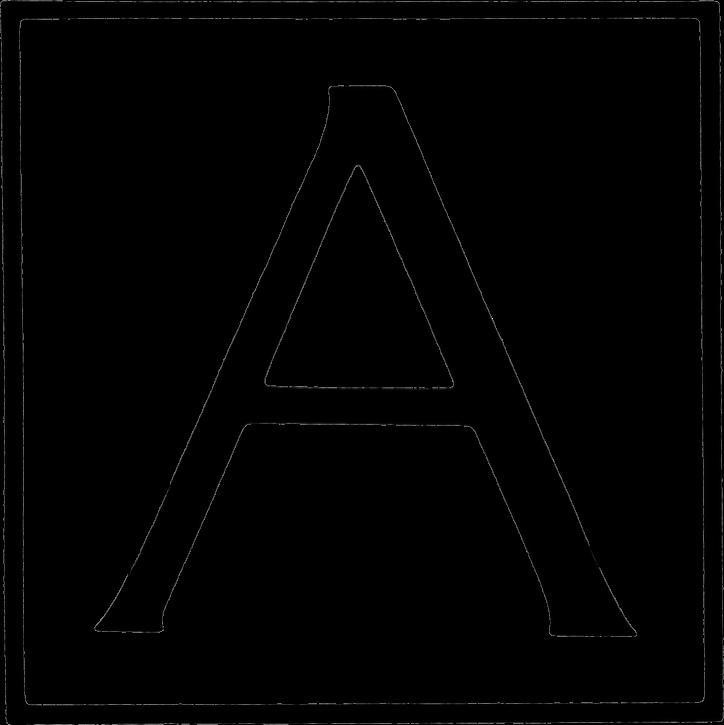
Images and text copyright 2025 The Annex Galleries
